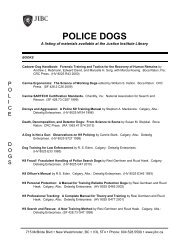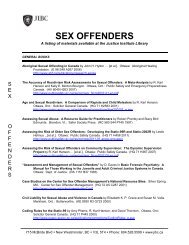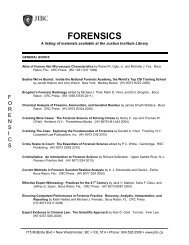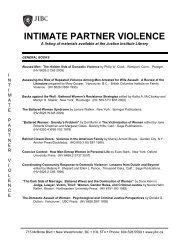legally speaking - Justice Institute of British Columbia
legally speaking - Justice Institute of British Columbia
legally speaking - Justice Institute of British Columbia
You also want an ePaper? Increase the reach of your titles
YUMPU automatically turns print PDFs into web optimized ePapers that Google loves.
arresting <strong>of</strong>ficer’s shoes, including a consideration <strong>of</strong><br />
their experience and training. The accused’s appeal<br />
was dismissed.<br />
Complete case available at www.courts.gov.bc.ca<br />
MOTORIST NOT ARBITRARILY<br />
DETAINED IF GROUNDS CAN BE<br />
CLEARLY EXPRESSED<br />
R. v. Adams, 2011 NLCA 3<br />
As drinking establishments were<br />
closing at about 3:30 a.m on a<br />
Saturday a police <strong>of</strong>ficer drove onto<br />
the parking lot <strong>of</strong> a shopping plaza<br />
which contained restaurants and a<br />
bar. He saw the accused’s vehicle pull out <strong>of</strong> a<br />
parking stall near the bar, drive slowly along the<br />
parking lot, and turn onto the street. There was no<br />
traffic coming but the vehicle turned very slowly and<br />
awkwardly. Although no <strong>of</strong>fences were committed<br />
under Newfoundland’s Highway Traffic Act, given<br />
the hour <strong>of</strong> the night, the proximity to the bar, the<br />
<strong>of</strong>ficer’s experience, and observing a slow and<br />
awkward turn, the <strong>of</strong>ficer decided to pull the vehicle<br />
over to “check the situation out." After the stop the<br />
accused subsequently provided breathalyzer<br />
readings <strong>of</strong> 110mg% and 130mg%.<br />
At trial in Newfoundland Provincial Court the judge<br />
found the stop was not arbitrary. He held the police<br />
<strong>of</strong>ficer “had a good reason for wanting to see what<br />
was going on.” There was no s. 9 Charter breach, the<br />
breathalyzer evidence was admitted, and the<br />
accused was convicted <strong>of</strong> operating a motor vehicle<br />
while his blood alcohol content exceeded 80 mg%.<br />
On appeal to the Newfoundland Supreme Court the<br />
breathalyzer evidence was excluded, the accused’s<br />
conviction was set aside, and an acquittal was<br />
entered. The appeal judge concluded the accused’s<br />
detention was based on nothing more than a hunch<br />
and was therefore arbitrary, breaching s. 9 <strong>of</strong> the<br />
Volume 11 Issue 1 - January/February 2011<br />
PAGE 9<br />
Charter. As well, relying on R. v. Mann, the appeal<br />
judge ruled that there was no nexus between the<br />
accused’s driving and a criminal <strong>of</strong>fence. The Crown<br />
then appealed to the Newfoundland Court <strong>of</strong><br />
Appeal.<br />
A breach <strong>of</strong> s. 9 <strong>of</strong> the Charter requires a detention<br />
to be “arbitrary”. The threshold for stopping a<br />
motorist, however, is relatively low and a motorist<br />
will not be arbitrarily detained if the <strong>of</strong>ficer has<br />
reasonable grounds that can be clearly expressed for<br />
stopping a particular, as opposed to any, vehicle. It<br />
must also be recognized that stopping motorists<br />
occurs in a different context than the investigative<br />
detention doctrine outlined in Mann, where the<br />
Supreme Court <strong>of</strong> Canada was dealing with police<br />
stopping an individual walking down a street, not<br />
driving a car. <strong>Justice</strong> Welsh, <strong>speaking</strong> for the New<br />
Brunswick Court <strong>of</strong> Appeal stated:<br />
[W]hen balancing the interests between the<br />
individual's right to privacy and legitimate police<br />
functions, the factors to be considered are<br />
different when the detention involves an<br />
individual walking down the street in an area<br />
where the police are searching for the<br />
perpetrator <strong>of</strong> an <strong>of</strong>fence from when the driver <strong>of</strong><br />
a motor vehicle is stopped for highway safety<br />
reasons such as impairment by alcohol. The<br />
concept <strong>of</strong> the nexus described in Mann has no<br />
practical application to the stopping and<br />
detention <strong>of</strong> a motorist as occurred in this case.<br />
[para. 16]<br />
Other Courts have recognized a distinction between<br />
a pedestrian and a motorist when balancing the<br />
competing interests <strong>of</strong> individual liberties and<br />
legitimate police functions, such as:<br />
• Motorists have a lower expectation <strong>of</strong> privacy<br />
in their vehicles than they do in their home;<br />
• Driving is highly regulated. Drivers know that<br />
they may be stopped for reasons pertaining to<br />
highway safety—as in a drinking-and-driving<br />
roadblock;<br />
“Given the social policy considerations associated with drinking and driving <strong>of</strong>fences ... the<br />
courts have adopted a relatively low threshold for determining what constitutes reasonable<br />
grounds for stopping a motorist for highway safety reasons such as impairment by alcohol.”






